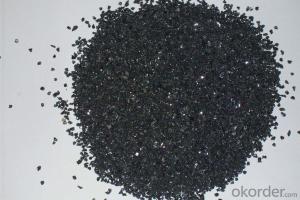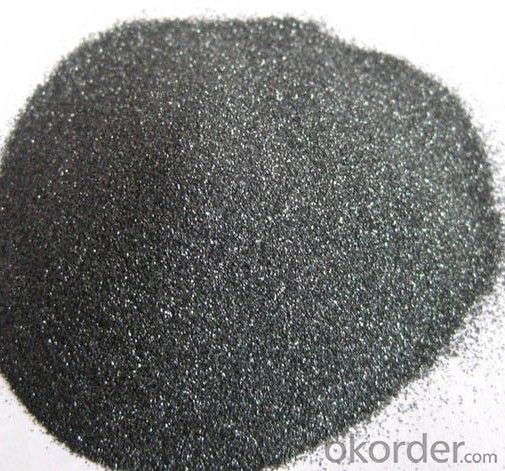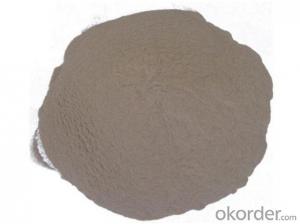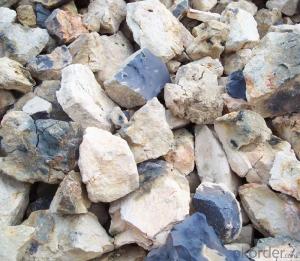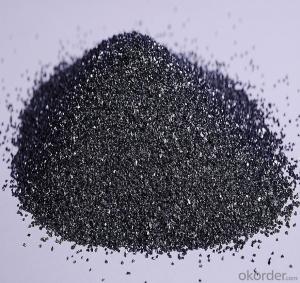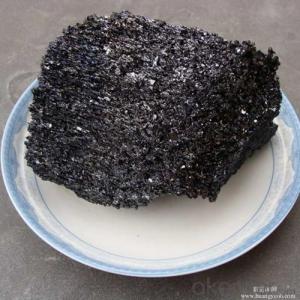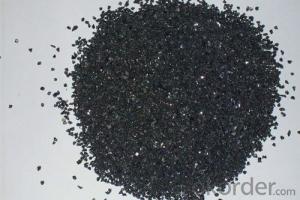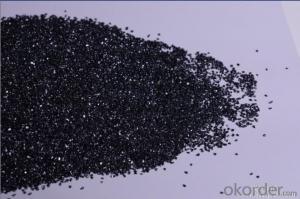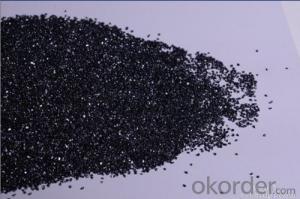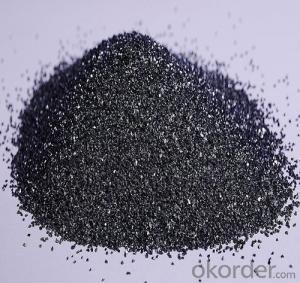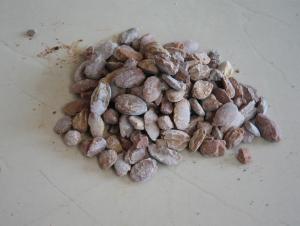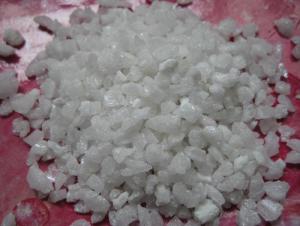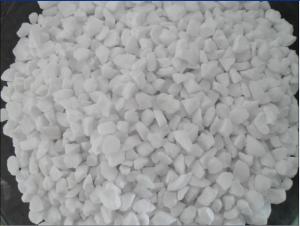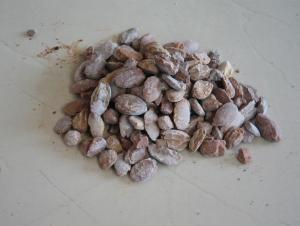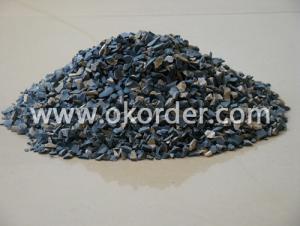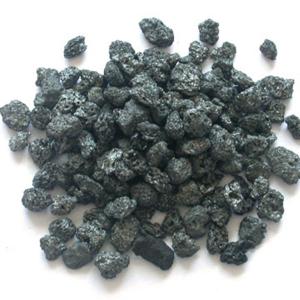Raw Materials for Refractory:Black Silicon Carbide (SiC >98% F10-F1600) for Refractory & Abrasives
- Loading Port:
- China main port
- Payment Terms:
- TT OR LC
- Min Order Qty:
- 25 m.t.
- Supply Capability:
- 2000 m.t./month
OKorder Service Pledge
OKorder Financial Service
You Might Also Like
SIC >98% F10-F1600 black silicon carbide for refractory&abrasives
Product Description
Black Silicon Carbide is produced in a high temperature electric resistance-type furnace from a mixture of quartz sand and petroleum coke.
The hardness of black silicon carbide is greater than fused alumina but less than synthetic diamond.
Its mechancial intensity is greater than fused alumina, but is brittle and very sharp. The mineral has some electrical and heat conductivity.
Black silicon carbide is typically used for machining or finishing cast iron ,non-ferrous metals, stone, leather, rubber, and other materials where sharp cutting characteristics are important .
Black Silicon Carbide is brittle and sharp and has electrical and heat conductivity in some degree.
Aplications :
Black Silicon Carbide is suitable for make grinding wheels, cutting wheels, mounted wheels, oil stone, abrasive media, and also suitable for surface grinding, lapping or polishing.
The abrasive products made of it are suitable for working on Cast Iron, Non-ferrous Metal, Rock, Leather, Rubber, Wood, Ceramic, etc.
Black Silicon Carbide is also broadly used as high-grade refractory material and metallurgical additive.
Available size :
| Grit | SiC | F.C. | Fe2O3 |
| F12-F90 | 98.50%min | 0.20%max | 0.60%max |
| F100-F150 | 98.00%min | 0.30%max | 0.80%max |
| F180-F220 | 97.00%min | 0.30%max | 1.20%max |
| F230-F400 | 96.00%min | 0.40%max | 1.20%max |
| F500-F800 | 95.00%min | 0.40%max | 1.20%max |
| F1000-F1200 | 93.00%min | 0.50%max | 1.20%max |
| P12-P90 | 98.50%min | 0.20%max | 0.60%max |
| P100-P150 | 98.00%min | 0.30%max | 0.80%max |
| P180-P220 | 97.00%min | 0.30%max | 1.20%max |
| P230-P500 | 96.00%min | 0.40%max | 1.20%max |
| P600-P15000 | 95.00%min | 0.30%max | 1.20%max |
| P2000-P2500 | 93.00%min | 0.50%max | 1.20%max |

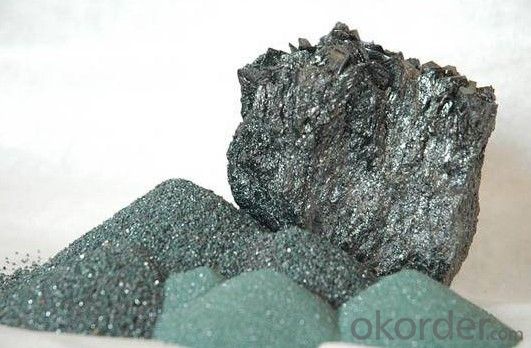
- Q: Can someone professionally introduce the classifications of refractories?
- It can be divided into two categories of ordinary and special refractory. Ordinary refractories can be devided into acidic, neutral and alkalinee refractories according to chemical properties. Special refractory can be devided into high temperature oxide, refractory compounds and high-temperature composite materials according to the compositions. Furthermore, it canbe devided into ordinary refractory products (1580 ~ 1770 ℃), advanced refractory products (1770 ~ 2000 ℃) and super refractory products (above 2000 ℃) according to the strength of refractoriness. It can be divided into bulks (standard brick, special-shaped brick, etc.), special shape (crucible, sagger, pipe, etc.), fibrous (aluminum silicate, zirconia and boron carbide, etc.) and Indefinite shape (refractory clay, castableand ramming mass, etc.) according to the shapes of products. According to the sintering process, it can be divided into sintered products, cast products, melting jetting products.
- Q: How to distinguish the fire resistant level of the rubber and plastic thermal insulation material?
- It is divided into level A, B1, B2 and B3. According to the current "burning behavior of building materials classification method", Level A insulation material is a non-combustible material, which belongs to YT. However, from the point of view of the current market , level A insulation material are very few, only glass wool, rock wool board, foam glass and vitrified micro bead. However, compared with level A insulation material, the more welcomed by the market is the organic insulation material. This is characterized as thermal insulation material, which is divided into three levels: level B1 is flame retardant, level B2 is flammable and level B3 is flammable. The level B1 nonflammable thermal insulation material is determined according to the fire endurance of the material. And different parts of the material are divided differently! Such as the common EPS / XPS insulation boards through special treatment of adding flame retardant. . Level B2 combustible insulation material is commonly the EPS expanded polystyrene foam insulation board and XPS board, that is, the ordinary plate. This material has low ignition point, and releases large amounts of harmful gases in the combustion process . Level B3 flammable insulation material is commonly the thermal insulation material taking polystyrene foam as the main material. Since this material is highly flammable, it has been out of the external wall thermal insulation materials. As for the civil construction insulation materials, China's current popular building insulation materials in the market are mainly made of three organic foams: EPS (molded polystyrene board), XPS (extruded polystyrene board) and PU (polyurethane).
- Q: How is the grading of the level A new material fire insulation material?
- The thermal insulation materials are generally divided into level A and level B according to the flame rating. Level A is the non-combustible material, and level B is the combustible materials. The level B material is to blame for the fire in Shenyang hotel in CCTV building a few years ago . At present, the level A materials are widely used, with some prices even cheaper than the level B material. A level is roughly divided into insulation mortar, phenolic board, rock wool board and foam cement board, ect.
- Q: What are the basic requirements of continuous casting for molten steel? What are the requirements for refractory materials?
- Refractories for continuous casting is an important part of the continuous casting machine, in addition to the characteristics of general refractory material, also for the purification of molten steel and improve the steel quality, stable molten steel temperature and composition, control and regulate the flow of the molten steel and other functions, so it is called functional refractories. The above is provided by the China Technology Department
- Q: How long usually will the A-level fireproof materials prevent the flame?
- Having a fire resistance test on any building components -----according to the standard time-temperature curve. This period starts from the time when affected by fire and ends up with losing the ability to support or to insulate fire or the integrity of the components. It can be expressed in hours. A-level fireproof materials can last for 2 hours.
- Q: Which kind of refractory floor is easy to use? ?
- Fireproof wood floor includes three types, and according to your requirement, I think that the third type is more suitable or is easier to use. Here are the three types, and you can choose form them. A. Wear-resistant composite solid wood floor It is also known as super durable multi-layer solid wood floor. Its surface is inorganic glass fiber material and special paper impregnation thermosetting amino?resin, composited with solid wood base materials like plywood or core-board. And also, its front is wear-resistant layer while the back is balance layer, then hot press it into grooved and tongued floor. This is a new impregnated paper laminate floor. It also has the same wear-resistant quality as laminate floor, comfort as solid wood floor, and stability as composite board. B. Fire-resistant wood-plastic composite decking board Wood-plastic composite decking board is not the wood floor in the traditional sense, but a composite material, also known as plastic wood. It is formed by high molecular improving and processing natural fiber, such as recycled plastic and wood fiber. It not only has the same advantages as plastic and wood, but alos has certain fire resistance, thus it is a environmentally friendly material with much development potential. C. Fireproof strengthened composite wood floor It is the so-called fireproof and fire retardant floor, fiber board, plywood and chipboard as its base materials. It is coated with fireproof coating and impregnated paper, and after fireproof and fire retardant technical process, it becomes a composite wood floor with some fire?retardant level. Its features are more partial to that of laminate floor with stable performance, steady structure and good durability.
- Q: What kind of foundry ingot refractory materials are there? Please be more detailed.
- Classification of refractory materials used in foundry smelting process: refractory brick, siliceous brick, high alumina brick, corundum brick, magnesia brick, magnesia brick, magnesia carbon brick. Unshaped refractory materials: ramming material, castable, refractory cement, silica, magnesia, etc.
- Q: Graphite and other carbon materials may be oxidized to CO or CO2 at high temperatures. But why can they be refractories?
- There is no contradiction for this. Any substance can be combustible, but different materials have different ignition points.There are many types of graphite. Pyrolytic graphite has a much lower ignition point. Therefore, as long as it reaches at a certain temperature, it can convert into graphite. Mostly, in practical applications (such as brake pads will add a certain amount of graphite), graphite is required to have refractoriness of below 1000 ℃. Graphite can serves as both the combustible and refractory material. So, it can be used as a fire-resistant and high-temperature-resisrant material because graphite (lamellar graphite) has a ignition point of at least 3000 degrees in an oxygen free condition. The above information is for reference only and is offered by Xin Ruida Graphite Company.
- Q: Firing high temperature kiln of refractory and internal temperature being as high as 1600 ℃, metal heat exchanger can't use, how to do?
- 1>3>。 When metal heat exchanger is in 700 ℃, it must process high temperature protection, mixed cold wind or cold blast to protect heat exchanger. So this will waste a lot of energy; The comparison of high temperature resistant ceramic heat exchanger using temperature is 1350 ℃ to 1450 ℃; metal heat exchanger using temperature 700 ℃; heat utilization comparison of ceramic heat exchanger can be placed in 1350 ℃ or higher (highest available to 1450 ℃); the oxidation resistance, a very short time will burn out;2 >, waste heat recovery rate is high. Replacing the metal heat exchanger in high temperature and corrosion environment; Comparative ceramic heat exchanger can be used under the condition of 1350 ℃ for a long time. Let's make a comparison, if it is a refractory material industry. <, ceramic heat exchanger is simply won't appear, under the condition of equal to ceramic heat exchanger using, energy saving effect is best, can exchange for the high temperature. <. Ceramic heat can be placed on the nearest of exchanger flue outlet . <, and metal heat exchanger put in place contrast to the ceramic heat exchanger. In the process of using metal heat exchanger, if this situation happens, you can consider the ceramic heat exchanger. Temperature difference is between 650 ℃ to 750 ℃. If the metal heat exchanger is placed in normal place where ceramic heat usually put;The service life comparison: since ceramic heat exchanger with high temperature resistance, this partly replace metal heat exchanger. What's more, energy-saving rate is also different. Metal heat exchanger can be placed in 700 ℃ or less;4 >, corrosion resistance, its application effect is very different. So the metal-heat-exchanger's heat-resistant temperature is high and the service life is the countless times of metal heat exchanger. The place with highest temperature does not need high temperature protection.
Send your message to us
Raw Materials for Refractory:Black Silicon Carbide (SiC >98% F10-F1600) for Refractory & Abrasives
- Loading Port:
- China main port
- Payment Terms:
- TT OR LC
- Min Order Qty:
- 25 m.t.
- Supply Capability:
- 2000 m.t./month
OKorder Service Pledge
OKorder Financial Service
Similar products
Hot products
Hot Searches
Related keywords
